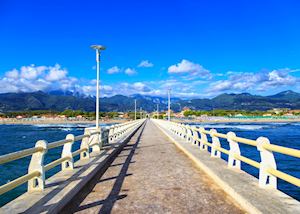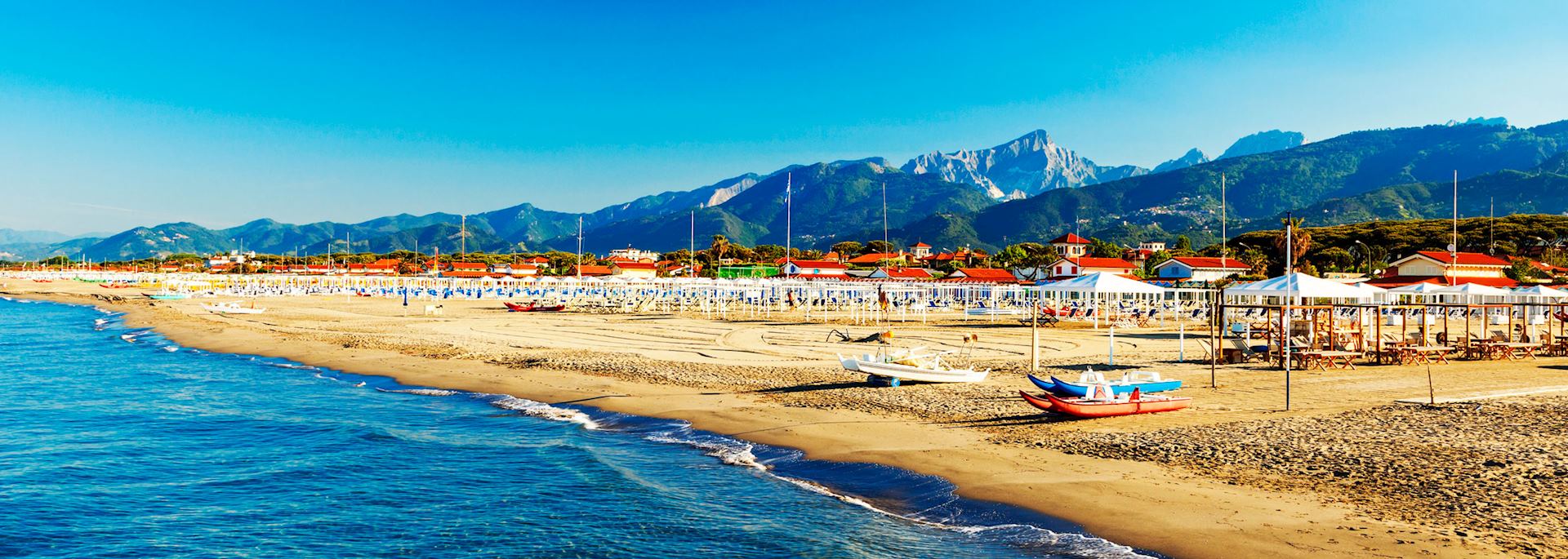Set on the Versilia Coast of Tuscany, Forte dei Marmi is sandwiched between the Ligurian Sea and the craggy, snow-capped peaks of the Apuan Alps. The town and its sandy stretch of Tuscan coastline has been popular with Italian and foreign visitors since the 19th century, when well-heeled urbanites flocked to the coastline in the summer months for a break from the city heat. Today, it’s a chic seafront retreat where grand villas hide in pine groves and designer boutiques and high-end restaurants line the streets. Rent a bike, cycle along the waterfront promenade and just soak it all in.
The beach is the main attraction in Forte dei Marmi and in typical Italian fashion, the full stretch is divided up between different beach clubs where visitors can rent loungers and sun umbrellas, dine at the restaurant and make use of the changing facilities. Behind it lies a long waterfront promenade and leafy streets lined with Liberty-style buildings and grand villas.
In the town, designer shops and gourmet dining options line the streets with major labels such as Fendi, Gucci, Prada and Dolce and Gabbana represented on two traffic-free, palm-lined main streets. For a more down-to-earth experience, Piazza Marconi has a local market every Wednesday morning and on Sunday mornings in the summer months.
 Cycling is the main way to get around town — all the hotels offer rentals and the coastal road, which runs parallel to the beach for miles and miles, boasts dedicated bike lanes. You’ll see visitors lazily cycling to and from the beach, but if you prefer to explore a little further afield, you could head south along the coast to the popular beach town of Viareggio where the bustling waterfront promenade is the heart of activity in the summer months. In winter, the town is the place to go for February’s carnival street parades which feature giant papier mâché floats.
Cycling is the main way to get around town — all the hotels offer rentals and the coastal road, which runs parallel to the beach for miles and miles, boasts dedicated bike lanes. You’ll see visitors lazily cycling to and from the beach, but if you prefer to explore a little further afield, you could head south along the coast to the popular beach town of Viareggio where the bustling waterfront promenade is the heart of activity in the summer months. In winter, the town is the place to go for February’s carnival street parades which feature giant papier mâché floats.
Another good spot for a day trip is Pietrasanta, just inland from Forte dei Marmi at the foot of the Apuan Alps. This small, historic town has long been renowned for its artists and sculptors. Local quarries supplied stone for Michelangelo and today the legacy is maintained by the tiny galleries and studios lining the streets. Its meandering lanes, small shops and modest cathedral make it a rewarding destination, and at just 15 minutes’ drive away, it’s also a good spot for dinner and an evening stroll in the setting sun.
Forte dei Marmi also makes a good base for visiting the Cinque Terre, about an hour and a half away, or the cities of western Tuscany including Lucca and Pisa.
Best time to visit
June and September are the best times to visit Forte dei Marmi — the weather is warm and dry but the summer crowds have yet to arrive. July and August are busy, with domestic visitors arriving in high numbers in August. April, May and October are also good times, though the weather can be unsettled, while many businesses close between November and March.
who's been there

Start planning your tailor-made trip to Forte dei Marmi by contacting one of our Tuscany specialists
- 617-223-4395
- Make an inquiry
Places near Forte dei Marmi
- Porto Venere 29 kilometers away
- Pisa 33 kilometers away
- Cinque Terre 39 kilometers away
- Portofino and Santa Margherita 86 kilometers away
- San Gimignano 90 kilometers away
- Florence 90 kilometers away
- Parma 95 kilometers away
- Modena 97 kilometers away
- Genoa 110 kilometers away
- Bologna 111 kilometers away
- Siena 118 kilometers away
- Ravenna 170 kilometers away
- Sirmione 171 kilometers away
- Verona 177 kilometers away
- Milan 185 kilometers away
- Lake Garda 186 kilometers away
- Barbaresco 187 kilometers away
- Gardone Riviera 187 kilometers away
- Alba 189 kilometers away
- Barolo 192 kilometers away
- Perugia 203 kilometers away
- Orvieto 210 kilometers away
- Umbria 219 kilometers away
- Assisi 222 kilometers away
- Como 223 kilometers away
- Blevio 225 kilometers away
- Torno 227 kilometers away
- Piedmont 227 kilometers away
- Laglio 229 kilometers away
- Turin 233 kilometers away
- Lezzeno 234 kilometers away
- Bellagio 237 kilometers away
- Venice 237 kilometers away
- Tremezzo 239 kilometers away
- Lake Como 242 kilometers away
- Stresa 250 kilometers away
- Verbania 253 kilometers away
- Lake Maggiore 256 kilometers away
- Madonna di Campiglio 257 kilometers away
- Rome 298 kilometers away
- Dolomites 302 kilometers away
- Costa Smeralda 321 kilometers away
- Alta Badia 322 kilometers away
- Sardinia 440 kilometers away
- Ischia 475 kilometers away
Photos of Forte dei Marmi
Our expert guides to exploring Forte dei Marmi
Written by our specialists from their own experiences of visiting Forte dei Marmi, these guides will help you make the most of your time there. We share both our practical recommendations and the best ways to appreciate Forte dei Marmi at its best.
-
Food highlights of Italy ![Italian market produce]()
Food highlights of Italy
Food highlights of Italy
Italy specialist Caroline talks about her love of Italian food in this guide, focusing on the more renowned culinary cities and regions. She also talks about her experiences of creating pasta, catching fresh fish for dinner in Sorrento, wine tasting in Tuscany's Chianti region and where to eat like a local.
Read this guide


